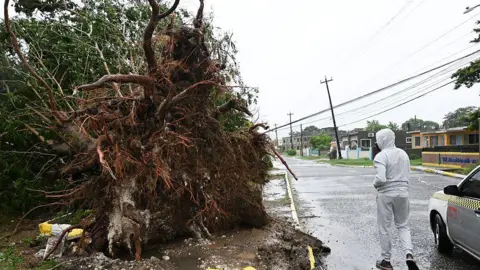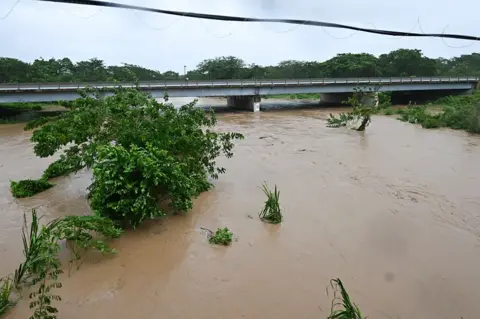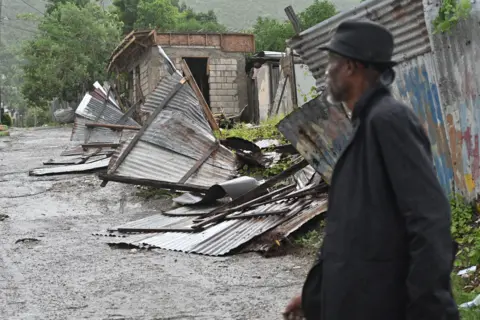 AFP via Getty Images
AFP via Getty ImagesHurricane Melissa is causing havoc in Jamaica as the Caribbean nation faces the strongest storm in its modern history.
The hurricane, a category four with wind speeds of 150mph (240km/h), was heading towards Cuba on Tuesday evening and then the Bahamas. Earlier, Melissa made landfall on Jamaica’s coastline with winds of more than 185mph.
Earlier in the day, a Meteorological Service of Jamaica official warned conditions would get “significantly worse” and the US National Hurricane Center predicted “catastrophic winds, flash flooding and storm surges”.
Jamaican authorities have urged residents and visitors to continue sheltering, with nearly a third of the country already without power.
Photos emerging from Jamaica since Hurricane Melissa made landfall show fallen trees and damaged homes.
“It’s a catastrophic situation,” the World Meteorological Organization’s tropical cyclone specialist Anne-Claire Fontan said at a press briefing, warning of storm surges up to four metres high.
“For Jamaica, it will be the storm of the century, for sure.”
Roofs have been torn off hospitals, former Jamaican senator Imani Duncan-Price told the BBC.
“People are trying to rescue people in the middle of the storm just to save lives.”
Up to 30 inches (76cm) of rain is expected in some parts, with areas already experiencing flash flooding. Around 70% of the island’s 2.8 million population lives within 5km of the sea.
 AFP via Getty Images
AFP via Getty ImagesWildlife is also a threat. Flooding may displace crocodiles from their natural dwellings, Jamaican health officials said.
“Rising water levels in rivers, gullies, and swamps could cause crocodiles to move into residential areas,” the South East Regional Health Authority said in a statement.
“Residents living near these areas are therefore advised to remain vigilant and avoid flood waters.”
Winston Warren, who said he lives less than 1km from the ocean, described “a constant roar of water”.
“There are times you just wonder – are the waves going to come crashing into your house?” he said. “We’ve seen a lot of roofs blown off.”
One woman told the BBC: “There is water coming in through the roof of my house. I am not okay.”
 EPA
EPAThe slow-moving storm is expected to remain powerful as it crosses Jamaica, whose highland communities are vulnerable to landslides and flooding.
Even before the eye of the hurricane reached land, the region experienced extreme weather and fatalities. On Monday, Jamaica’s government said three people had died in “storm-related” incidents, involving falling trees.
The storm is heading towards Santiago de Cuba, Cuba’s second-largest city.
In Cuba, authorities said they evacuated about 500,000 people from areas vulnerable to winds and flooding.
“Melissa will arrive with force, and there’s great concern about what it could destroy in its wake,” Cuban President Miguel Diaz-Canel said in a message published in state newspaper Granma.
Additional reporting by Brandon Drenon and Gabriela Pomeroy

